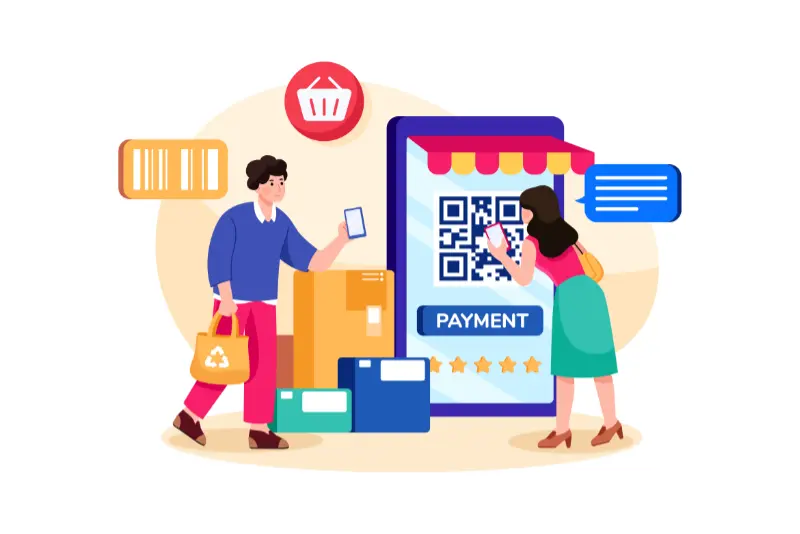What are the e-commerce costs for online merchants?
While a retailer selling online doesn’t need a brick-and-mortar store, it does need to sell its products online and requires some resources that cost money.
Before someone can sell something, the retailer needs a product. It’s no different in the retail store. In addition to product manufacturing, transportation and customs are added to the cost.
To sell the products online, the retailer needs an EAN/GTIN number for the product. If this is not available, a GTIN number must be purchased starting at € 35 net per year.
Likewise, the distributor must register the product with the Central Office in the Packaging Register. Prices are based on quantity formation and weight. The price starts from 39 € net per year.
Store development and maintenance costs
Instead of a brick-and-mortar store, online retailers need an online store or blog with an integrated store.
For this, merchants may have to pay costs for the development and maintenance of the website and/or e-commerce platform.
This includes costs for the design, programming and maintenance of functions such as payment processing, product catalogs, order processing and customer accounts.
There are many ready-installed store solutions that allow even users without programming skills to build and maintain their own store.
Ready-made store solutions with web hosting include:
- Shopify
- CosmoShop
- wix.com
- epages
- Gambio
- xt:Commerce
- JTL Shop
Store software that needs to be installed:
- Shopware
- Oxid
- Magento
- PrestaShop
Store software for the blog with WordPress:
- WooCommerce
Store Software Cost?
Open source software:
There is free open source software like WordPress and one version each of Shopware, Magento and Oxid.
With this software, the source code is accessible, may be modified and installed on your own server.
For open source software there are already many extensions(plugins) and templates(themes).
Ready-made store solutions:
Pre-installed solutions like Shopify, Gambio or epages hardly allow any changes to the source code.
These systems allow a quick start and are ideally suited as a standard solution for a store.
There are free and paid extensions for this as well.
Prices for a ready-made store solution start at 15 € per month.
Customized store solutions:
If you want to create a more elaborate online store, you should use a professional version.
The cost of the software starts at 2000 € per month.
These systems make almost everything possible. However, it requires employees who can operate the system and developers who can extend the store as desired.
Payment processing fees
Any seller who sells their products online can’t take cash like they can in a retail store.
He must offer payment processing to the customer. The more payment options offered, the lower the purchase abandonment.
The payment method includes purchase on account, payment by direct debit, bank transfer, payment by credit card.
While a merchant can still manage a purchase on account, by direct debit and bank transfer, this no longer works with credit cards.
Then the merchant must use a payment provider, called Payment Service Provider(PSP), such as PayPal, Stripe Payment, Klarna, Mollie, Google Pay, Amazon Pay or Apple Pay.
Using a PSP takes a lot of the work out of it and builds trust with the customer. However, the merchant must pay a fee for each transaction.
In addition to a possible monthly basic fee, there are fixed fees per transaction starting at € 0.35 and plus a percentage fee averaging 2 % of sales.
Overview PSP fees on Händlerbund ➚
The most popular payment method on the Internet in Germany is “purchase on account”.
Storage and fulfillment costs
Online retailers need to store their products. First, the items are often stored at home and in the garage.
Then the dealer should remember that he must report the use of the premises as a business to the local office or landlord.
If the premises are registered, the dealer needs storage insurance, which starts at € 200 net per year.
Because if the items cause damage or are destroyed themselves, without a report and insurance, the damage will not be covered.
Shipping to customers is also often handled by the company itself in the beginning. The amount of these costs depends on the size and weight of the products, the number of orders and the shipping options chosen. Here, on average, up to € 10 is spent per item (see below).
At some point, everyone reaches their limits. The storage space is no longer enough, assembling and packing the items takes too long, labeling the packages gets messed up, and transporting the packages to the post office becomes more difficult and takes time.
As your online business grows, everyone comes to the point that they need a fulfillment service provider for these tasks.
With outsourcing fulfillment, the retailer has the flexibility to grow and launch sales promotions without worrying about how they will get orders fulfilled.
cost of an external warehouse for goods, is on average 14 € per m². Pick and pack costs vary, but roughly average € 1.85 per item.
Calculate the fulfillment costs for your goods online.
Use marketplaces
Selling through marketplaces and multiple channels has become very important in e-commerce.
Either the retailer uses multichannel marketing in addition to its online store or it sells its products exclusively via marketplaces.
Marketplaces offer the advantage that millions of customers willing to buy are already present there. For the online retailer mostly a payment service and a fulfillment center are available.
Actually, the merchant only needs to create the products with product description and product images.
He sends the goods to the respective center or uses the fulfillment of a third party fulfillment service provider, who sends the goods directly to the end customer after receipt of the order, Fulfillment by Merchant (FBM).
Of course, the marketplaces charge fees for each transaction, plus storage and fulfillment services. The sales fees are mostly between 8 and 15 % of the turnover.
Popular marketplaces are Amazon, eBay Zalando and Otto. But there are also marketplaces that occupy niches, such as allegro, limango or fruugo.
It is important that the fulfillment center has an interface to this marketplace or that the retailer uses an ERP system such as Billbee or Afterbuy to centrally bundle orders from multiple channels.
Online marketing costs
While a business may occur more often in each location on different streets, the competition is much tougher in online marketing.
The merchant must be found with his products on Goolge in the search results or in the shopping entries. Here, however, there are only 10 places that receive attention. Almost no user opens the second page on Goolge.
Also, when Google takes into account the user’s location and includes local results, the comparison on the Internet is much more direct.
The same applies to Amazon, eBay and Otto.
How can the online retailer market itself?
He can ensure a better ranking on Google, eBay and Amazon with a good product description and good customer reviews. That requires time, knowledge and a good SEO strategy.
If it should go faster, the online retailer can spend money on marketing and advertising to make the products known and attract customers.
The merchant pays per click on the advertisement. These include social media advertising, Google AdWords or influencer marketing. The CPC costs are on average 5 € net per click. A daily budget of less than €100 makes little sense because the ads are not displayed enough.
If the merchant uses Google AdWords, he should integrate remarketing to get a higher CTR (clickthrough rate). Many internet users, do not click on the ad until they see it for the third time on different platforms.
Costs for legal advice
The legal aspects have increased significantly in recent years. To comply with all legal points is almost impossible. Almost every online retailer receives a warning letter from lawyers.
In the last year 2022, the warning letters for the use of Goolge fonts in the store, which were not locally embedded, really exploded.
The merchant needs its own terms and conditions, privacy policy, imprint and revocation form. He must consider many things, such as the price, compliance with the DSGVO, trademark law, competition law and much more.
Some lawyers have specialized in the extensive subject. An online merchant should consult a lawyer and have everything reviewed.
Since lawyers are very expensive, IT-Recht ➚ offers a good starter package for start-ups for € 9.90 net per month. Here, however, the dealer must carry out the implementation himself.
Customer support costs
Online retailers should provide their customers with extensive support during the ordering phase and in the after-sales service.
To do this, you should plan for customer support, including employing customer service representatives, possibly in different languages, or using software such as chatbots.
The better retailers build customer support, the lower shopping cart abandonment and returns can be.
In addition to the costs for the employees, there are also costs for the chatbot software ➚. Prices range from € 14 to € 750 net per month.
Customer support is also offered by some fulfillment service providers and can thus be outsourced.
Taxes and duties
Online retailers have to pay different taxes and duties such as VAT on their sold products depending on the country and region.
If Amazon sellers use the PAN-EU program, they must comply with very complex tax regulations. A specialized service provider should definitely be used here.
Costs for shipping and returns in e-commerce
One of the biggest challenges in e-commerce is the reliable shipment of goods to the end customer and their costs.
Especially in Germany, online customers are spoiled and less accepting when additional shipping costs are added to the purchase price.
Costs for returns are also unpopular, but since 2014 they have been allowed to be charged to the customer under the EU Consumer Rights Directive.
How does the competition do it?
Should the shipping costs be included in the price or rather plus.
Surely it depends on the cart value. The higher this is, the more likely it is that the costs can be integrated into the sales price.
But is that really fair to the consumer?
Finally, everyone then pays an average shipping and returns price, even though their shipping route may be shorter and not use returns.
This means that if shipping prices are included, each customer always pays a little more.
Comparison of shipping and returns costs in e-commerce?
As a percentage of online retailers surveyed
Number of respondents: 2018 n=95, unanswered by 11 respondents
Source: EHI Retail Institute ® Handelsdaten 2021
Average logistics costs in the market per item in e-commerce
The chart shows the average shipping costs per item in e-commerce in 2018. The study was created as part of the EHI study “Shipping and returns management in e-commerce 2019”.
95 well-known online retailers from Germany, Austria and Switzerland were surveyed, 67% of whom are also stationary.
Certainly the costs in e-commerce fluctuate and depend on the respective articles. That’s why you’ll always receive a current offer from us that’s tailored to your needs.
As an online retailer, you know your own fulfillment costs. But are they in line with the market average?
We can help you to reduce the logistics costs in your online shop! You will also save a lot of time and work.



